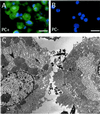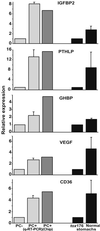A molecular profile of the mouse gastric parietal cell with and without exposure to Helicobacter pylori
- PMID: 11717430
- PMCID: PMC61102
- DOI: 10.1073/pnas.231332398
A molecular profile of the mouse gastric parietal cell with and without exposure to Helicobacter pylori
Abstract
The parietal cell (PC) plays an important role in normal gastric physiology and in common diseases of the stomach. Although the genes involved in acid secretion are well known, there is limited molecular information about other aspects of PC function. We have generated a comprehensive database of genes expressed preferentially in PCs relative to other gastric mucosal cell lineages. PCs were purified from FVB/N mouse stomachs by lectin panning. cRNA generated from PC-enriched (PC(+)) and PC-depleted (PC(-)) populations were used to query oligonucleotide-based microarrays. False-positive signals were filtered by using a new algorithm for noise reduction and selected results independently audited by real-time quantitative reverse transcription (RT)-PCR. The annotated database of 240 genes reveals previously unappreciated aspects of cellular function, including factors that may mediate PC regulation of gastric stem cell proliferation. PC(+) and PC(-) expression profiles were also prepared from germ-free mice 2 and 8 weeks after colonization with a clinical isolate of Helicobacter pylori (Hp)--the pathogen that produces acid-peptic disease (gastritis, ulcers) in humans. Whereas PC(+) gene expression was remarkably constant, the PC(-) fractions demonstrated a robust, evolving host response, with increased expression of genes involved in cell motility/migration, extracellular matrix interactions, and IFN responses. The consistency of PC(+) gene expression allowed identification of a cohort of 92 genes enriched in PCs under all conditions studied. These genes provide a molecular profile that can be used to define this epithelial lineage under a variety of physiologic, pharmacologic, and pathologic stimuli.
Figures



References
-
- Karam S M, Leblond C P. Anat Rec. 1993;236:259–279. - PubMed
-
- Karam S M, Leblond C P. Anat Rec. 1993;236:280–296. - PubMed
-
- Karam S M, Leblond C P. Anat Rec. 1993;236:297–313. - PubMed
-
- Karam S M. Anat Rec. 1993;236:314–332. - PubMed
-
- Li Q, Karam S M, Gordon J I. J Biol Chem. 1996;271:3671–3676. - PubMed
Publication types
MeSH terms
Grants and funding
LinkOut - more resources
Full Text Sources
Other Literature Sources
Research Materials
Miscellaneous

